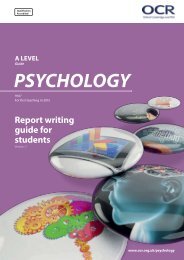PSYCHOLOGY
2bwO2e
2bwO2e
Create successful ePaper yourself
Turn your PDF publications into a flip-book with our unique Google optimized e-Paper software.
Developmental Psychology<br />
External influences on children’s behaviour – Bandura, Ross and Ross<br />
BANDURA, A., ROSS, D. and ROSS, S. A. (1961)<br />
Transmission of aggression through imitation of aggressive models.<br />
Journal of Abnormal and Social Psychology, 63, (3), 575-582.<br />
6. Key findings<br />
• Children in the aggressive condition showed significantly more imitation of physical and verbal aggressive behaviour and non-aggressive verbal<br />
responses than children in the non-aggressive or control conditions.<br />
• Children in the aggressive condition showed more partial imitation and non-imitative physical and verbal aggression than those in the nonaggressive<br />
or control conditions. Results here were however not always significant.<br />
• Children in the non-aggressive condition showed very little aggression, although results were not always significantly less than the control<br />
group.<br />
• Children who saw the same sex model imitated the model’s behaviour significantly more in the following categories:<br />
(i) Boys imitated male models more than girls for physical and verbal aggression, non-imitative aggression and gun play.<br />
(ii) Girls imitated female models more than boys for verbal imitative aggression and non-imitative aggression. However results were not significant.<br />
• The behaviour of the male model exerted greater influence than the female model.<br />
• Overall boys produced more imitative physical aggression than girls.<br />
7. Possible conclusions<br />
• Children will imitate aggressive/non-aggressive behaviours displayed by adult models, even if the model is not present.<br />
• Children can learn behaviour though observation and imitation.<br />
• Behaviour modelled by male adults has a greater influence on children’s behaviour than behaviour modelled by a female adult.<br />
• Both boys and girls are more likely to learn highly masculine-typed behaviour such as physical aggression from a male adult rather than a<br />
female.<br />
• Boys and girls are likely to learn verbal aggression from a same-sex adult.<br />
29





